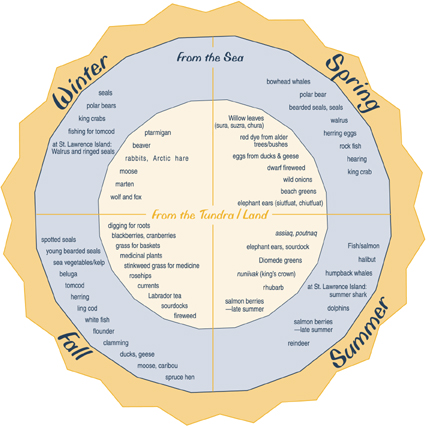 "Ugiuvaŋmiuraaqtuaksrat" "Ugiuvaŋmiuraaqtuaksrat"
Future King
Island Speakers
APPENDIX
A
A Word About My Cultural Resources
When I began my project, I spoke to King
Island elders, Rose Koezuna and Cecelia Muktoyuk. They lived on King Island
until the school and church
were closed.
Rose is my older sister by twenty-five years. Every time I need a confirmation
that a word or words are correctly said, I would call on her. When I learned
to write Inupiaq. I wrote and she spoke. Cecelia died of cancer last summer.
She was my teasing cousin who loved working with me since she can “correct” me
as her teasing cousin. Her question to me was always “When will you
learn?” Being
on King Island with these two elders and my other sister, Agatha Kokuluk
was the most valuable lesson to the younger generations and me.
While our
dance group, “Ugiuvangmiut King Island Dancers” performed
at the Teller Cultural Festival, my family stayed at Maria’s Omiak’s
house. Listening to her and Sylvester Ayek, David Alvanna, Vincent Pikgonganna,
and John Penetac, I realized they were the last children raised on King
Island. I sat down with Marie and Sigwein (her husband) to list all the
children from
her generation. They named 37 people in a ten-year generation. That was
the beginning of my estimate count of King Island language speakers.
APPENDIX B
Below is an article I wrote for the newsletter, Sharing Our Pathways” in
2003. It is about creating a seasonal circular calendar of our subsistence
lifestyle in the Bering Strait region while I was working as an Inupiaq Region
Lead Teacher for the Alaska Rural Systemic Initiative. This calendar can be
used as a reference for both mentors and language learners when they are ready
to move deeper into their lessons.
Sharing Our Pathways
A newsletter of the Alaska Rural Systemic Initiative
Alaska Federation of Natives / University of Alaska / National Science Foundation
Volume 8, Issue 1, January/February 2003
Iñupiaq Region: Integrating Culturally Responsive School Standards
in Education
by Yaayuk Bernadette Alvanna-Stimpfle, Iñupiaq Lead Teacher
Last fall, the Bering Strait School District held their Third Annual Educational
Conference from October 21—24. There were many workshops and meetings
offered for all the participants from the fifteen sites within the region.
It was exciting to see so many teachers coming together from the Bering Strait
region.
On Tuesday, October 22 during the breakout sessions I facilitated two sessions
on "Integrating Culturally-Responsive Standards." At both sessions
I guided the participants in brainstorming on subsistence activities throughout
each season.
In the first group, there were enough participants to break up into smaller
groups to help each other in preparing lessons. In each of the groups, it was
suggested that we create a circular calendar listing the seasonal activities.
Teachers can brainstorm with students and have them create a subsistence calendar.
The illustration opposite shows activities both groups came up with.
Suggested Activities for Implementation of Subsistence-based
Curriculum
- Have students brainstorm what activities are happening in the community.
- Create a circular seasonal calendar to record and display traditional
activities with these labels:
| Early spring |
Summer |
Early fall |
| Late fall |
Winter |
|
- If possible, include the Native names of each season.
- Have students illustrate the calendar.
- Have students research and interview Elders or local experts.
- Compare and contrast traditional and modern subsistence activities.
- Create a website on the activities.
- Participate and get involved in the community activities.
- Invite guests for storytelling.
- Create and display student work.
- Hold a science fair on the research done by the students.
Assessment and Rubrics
- Teachers can create an assessment and a scoring guide for the projects.
Performance Assessment
- Hold a community night to display student work.
(The seasonal calendar):

Related winter activities include trapping, hunting, dog sledding, Native
dancing and potluck celebrations, storytelling, sewing parkas, mukluks, mittens,
slippers, ruffs and carving with ivory, wood or baleen. Sports-related activities
include basketball, volleyball and wrestling. Native games include the World
Eskimo Indian Olympics games such as the High Kick and Finger Pull.
Related spring activities include bear hunting, hunting out in the sea ice,
drying meat, making seal oil and preparing for summer fish camp. Many hours
are spent preparing and putting away dried foods.
Related fall activities include ivory carving, hunting, skin sewing, knitting,
weaving grass baskets, ice fishing and preparing for the winter holidays. Some
communities can practice Native dancing and children can do different sports
related to the curriculum (Native games).
Related summer activities include fishing, going to fish camps to prepare
dried salmon, picking various greens, picnics, put away dried fish and meat,
store edible greens and seal oil, freeze berries for the winter. Communities
have their own techniques to prepare salmon and greens–have students
research that in their communities.
Related summer activities include fishing, going to fish camps to prepare
dried salmon, picking various greens, picnics, put away dried fish and meat,
store edible greens and seal oil, freeze berries for the winter. Communities
have their own techniques to prepare salmon and greens–have students
research that in their communities.
I know there are many activities I have left out from this list. Teachers
can add them with their students. Both sessions I worked with were very good
about sharing their activities and lessons.
Quyaana to all the participants who were part of the workshop during
the BSSD Education Conference!
TABLE OF
CONTENTS
|